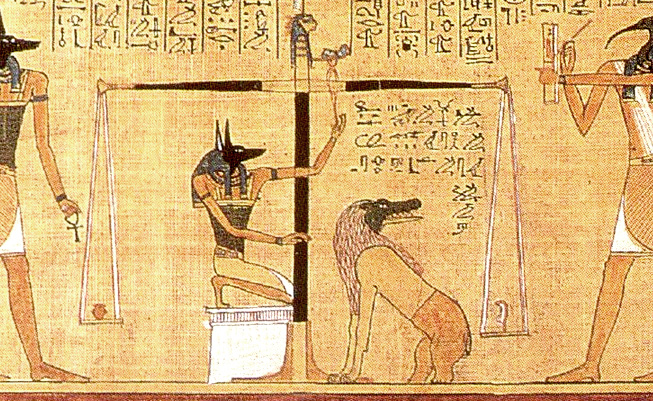Scales from the Stone Age to today: worth the weight?

I’ve written elsewhere on this blog about how Richard Salter invented the spring scale and how that changed the face of weighing.
Before then, weighing scales had already been in use for thousands of years. The oldest evidence for their existence dates to roughly 2400-1800 BC in the Indus River valley (modern-day Pakistan), where polished stone cubes have been discovered in early settlements. These were almost certainly used as weight-setting stones in balance scales for, although the cubes bear no markings, their weights are multiples of a common denominator.
In the Egyptian Book of the Dead, a funerary text used between about 1500 to 50 BC, one illustration depicts the jackal-headed god Anubis using a balance scale to compare the weights of a man’s heart and a feather; if the man’s heart is lighter, he gets to pass into the afterlife, otherwise his spirit gets eaten by a beast that’s part crocodile, part lion and part hippo! As justice goes, that’s a pretty harsh system!
Weighs and means
It’s all a far cry from what scales are capable of today and you can’t help but think how much more efficient Anubis’ operation would have been with a good set of modern bench scales.
Today, measuring the weight of an item is just a small part of what a good weighing scale can do. Parts counting, check weighing, tare facilities, percentage weighing, totalising – these are all things within the capability of many of the scales now available. You may not be aware what all these things mean, but don’t worry, because over on our Google+ page, I will shortly be launching a series in which I explain each and every one of them! To be fair, most could be performed with a calculator, a good ‘O’ level in maths and a bit of patience, but in today’s highly competitive market, these are functions on retail and industrial scales that can significantly speed up your operations.
Strange weighs here we come
One less common feature, although very practical in certain fields, is ‘dynamic weighing’, which allows you to weigh an animal that refuses to sit still, as many animals are wont to do. Basically, as the creature wanders about the weighing platform, the scale takes an average weight over a period of time.
My favourite feature, though, is called ‘eccentric loading’, although it isn’t, as I first thought, anything to do with approaching the scales in the style of John Cleese in Monty Python’s Ministry of Silly Walks. It actually just means that the scale will make the same reading no matter where on the platform you place your item.
Weighing animals and placing items to be weighed on the scales in an odd manner are not likely to be near the top of the list of requirements for many of our Customers, so these are not functions I shall linger on any further. However, as I have indicated, I will be returning to the more generally useful features mentioned and discussing which of our floor, bench and platform scales they apply to. You can take a look at our range on our website now, or give our Sales team a call on 0844 800 9844.
Dave Smith
Latest posts by Dave Smith (see all)
- An environmental guide to plastic carrier bags - 22nd June 2015
- Millimetres and litres: a guide to choosing the right sized box - 11th June 2015
- The Davpack Christmas Sale – There’s More! - 12th November 2014
